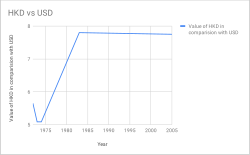Money supply
The money supply (or money stock) is the total value of money available in an economy at a point of time. There are many ways to define "money". Normal measures usually include currency in circulation and demand deposits.[1][2] Each country’s central bank may use its own definitions of what they consider to be money for its purposes.
Money supply data is recorded and published. It is done usually by the government or the central bank of the country. Public and private sector analysts look at changes in the money supply. This is because they believe that changes affect the price level of securities, inflation, the exchange rates and the business cycle.[3]
Empirical measures in the United States Federal Reserve System
Money is used as a medium of exchange, a unit of account, and as a ready store of value.
The different types of money are typically classified as "M"s. The "M"s usually range from M0 (narrowest) to M3 (broadest) but which "M"s are actually focused on in policy formulation depends on the country's central bank. The typical layout for each of the "M"s is as follows:
| Type of money | M0 | MB | M1 | M2 | M3 | MZM |
|---|---|---|---|---|---|---|
| Notes and coins in circulation (outside Federal Reserve Banks and the vaults of depository institutions) (currency) | ✓[4] | ✓ | ✓ | ✓ | ✓ | ✓ |
| Notes and coins in bank vaults (vault cash) | ✓ | |||||
| Federal Reserve Bank credit (required reserves and excess reserves not physically present in banks) | ✓ | |||||
| Traveler's checks of non-bank issuers | ✓ | ✓ | ✓ | ✓ | ||
| Demand deposits | ✓ | ✓ | ✓ | ✓ | ||
| Other checkable deposits (OCDs), which consist primarily of negotiable order of withdrawal (NOW) accounts at depository institutions and credit union share draft accounts. | ✓[5] | ✓ | ✓ | ✓ | ||
| Savings deposits | ✓ | ✓ | ✓ | |||
| Time deposits less than $100,000 and money-market deposit accounts for individuals | ✓ | ✓ | ||||
| Large time deposits, institutional money market funds, short-term repurchase and other larger liquid assets[6] | ✓ | |||||
| All money market funds | ✓ |
- M0: In some countries, such as the United Kingdom, M0 includes bank reserves, so M0 is referred to as the monetary base, or narrow money.[7]
- MB: is referred to as the monetary base or total currency.[4] This is the base from which other forms of money (like checking deposits, listed below) are created and is traditionally the most liquid measure of the money supply.[8]
- M1: Bank reserves are not included in M1.
- M2: Represents M1 and "close substitutes" for M1.[9] M2 is a broader classification of money than M1. M2 is a key economic indicator used to forecast inflation.[10]
- M3: M2 plus large and long-term deposits. Since 2006, M3 is no longer published by the US central bank.[11] However, there are still estimates produced by various private institutions.
- MZM: Money with zero maturity. It measures the supply of financial assets redeemable at par on demand. Velocity of MZM is historically a relatively accurate predictor of inflation.[12][13][14]
The ratio of a pair of these measures, most often M2 / M0, is called an (actual, empirical) money multiplier.
Money Supply Media
CPI-Urban (blue) vs M2 money supply (red); recessions in gray
Japanese money supply (April 1998 – April 2008)
The euro money supplies M0, M1, M2 and M3, and euro zone GDP from 1980–2021. Logarithmic scale.
M4 money supply of the United Kingdom 1983–2024. In millions of pounds sterling.
References
- ↑ Alan Deardorff. "Money supply," Deardorff's Glossary of International Economics
- ↑ Karl Brunner, "money supply," The New Palgrave: A Dictionary of Economics, v. 3, p. 527.
- ↑ The Money Supply – Federal Reserve Bank of New York. Newyorkfed.org.
- ↑ 4.0 4.1 "Gold, Oil, Stocks, Investments, Currencies, and the Federal Reserve: Growth of Global Money Supply" Archived 2015-09-15 at the Wayback Machine. DollarDaze Economic Commentary Blog by Mike Hewitt.
- ↑ M1 Money Stock (M1) – FRED – St. Louis Fed. Research.stlouisfed.org.
- ↑ M3 Definition. Investopedia (February 15, 2009).
- ↑ M0 (monetary base). Moneyterms.co.uk.
- ↑ "M0". Investopedia. Archived from the original on 2018-03-30. Retrieved 2008-07-20.
- ↑ "M2". Investopedia. Retrieved 2008-07-20.
- ↑ "M2 Definition". InvestorWords.com. Archived from the original on 2008-07-13. Retrieved 2008-07-20.
- ↑ Discontinuance of M3, Federal Reserve, November 10, 2005, revised March 9, 2006.
- ↑ Aziz, John (March 10, 2013). "Is Inflation Always And Everywhere a Monetary Phenomenon?". Azizonomics. Archived from the original on 13 March 2013. Retrieved 2 April 2013.
- ↑ Thayer, Gary (January 16, 2013). "Investors should assume that inflation will exceed the Fed's target". Macro Strategy. Wells Fargo Advisors. Archived from the original on 14 July 2014. Retrieved 2 April 2013.
- ↑ Carlson, John B.; Benjamin D. Keen (1996). "MZM: A monetary aggregate for the 1990s?" (PDF). Economic Review. Federal Reserve Bank of Cleveland. 32 (2): 15–23. Archived from the original (PDF) on 4 September 2012. Retrieved 2 April 2013.
Other websites
- Aggregate Reserves Of Depository Institutions And The Monetary Base (H.3)
- Historical H.3 releases
- Money Stock Measures (H.6)
- U.S. MZM magnitude and velocity, used as a predictor of inflation
- Data on Monetary Aggregates in Australia
- Monetary Statistics on Hong Kong Monetary Authority
- Monetary Survey from People's Bank of China








